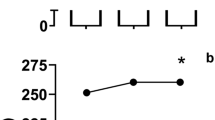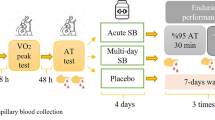Abstract
Background
Current evidence suggests sodium bicarbonate (NaHCO3) should be ingested based upon the individualised alkalotic peak of either blood pH or bicarbonate (HCO3 −) because of large inter-individual variations (10–180 min). If such a strategy is to be practical, the blood analyte response needs to be reproducible.
Objective
This study aimed to evaluate the degree of reproducibility of both time to peak (TTP) and absolute change in blood pH, HCO3 − and sodium (Na+) following acute NaHCO3 ingestion.
Methods
Male participants (n = 15) with backgrounds in rugby, football or sprinting completed six randomised treatments entailing ingestion of two doses of 0.2 g·kg−1 body mass (BM) NaHCO3 (SBC2a and b), two doses of 0.3 g·kg−1 BM NaHCO3 (SBC3a and b) or two control treatments (CON1a and b) on separate days. Blood analysis included pH, HCO3 − and Na+ prior to and at regular time points following NaHCO3 ingestion over a 3-h period.
Results
HCO3 − displayed greater reproducibility than pH in intraclass correlation coefficient (ICC) analysis for both TTP (HCO3 − SBC2 r = 0.77, P = 0.003; SBC3 r = 0.94, P < 0.001; pH SBC2 r = 0.62, P = 0.044; SBC3 r = 0.71, P = 0.016) and absolute change (HCO3 − SBC2 r = 0.89, P < 0.001; SBC3 r = 0.76, P = 0.008; pH SBC2 r = 0.84, P = 0.001; SBC3 r = 0.62, P = 0.041).
Conclusion
Our results indicate that both TTP and absolute change in HCO3 − is more reliable than pH. As such, these data provide support for an individualised NaHCO3 ingestion strategy to consistently elicit peak alkalosis before exercise. Future work should utilise an individualised NaHCO3 ingestion strategy based on HCO3 − responses and evaluate effects on exercise performance.

Similar content being viewed by others
References
Atkinson G, Nevill AM. Statistical methods for assessing measurement error (reliability) in variables relevant to sports medicine. Sports Med. 1998;26:217–38.
Barnett C, Snel A, Omari T, Davidson G, Haslam R, Butler R. Reproducibility of the 13C-octanoic acid breath test for assessment of gastric emptying in healthy preterm infants. J Pediar Gastroenterol Nutr. 1999;29:26–30.
Bishop D, Edge J, Davis C, Goodman C. Induced metabolic alkalosis affects muscle metabolism and repeated-sprint ability. Med Sci Sports Exerc. 2004;36:807–13.
Bland JM, Altman GD. Statistical methods for assessing agreement between two methods of clinical measurement. Lancet. 1986;1(8476):307–10.
Cairns SP. Lactic acid and exercise performance: culprit or friend? Sports Med. 2006;36:279–91.
Carr AJ, Hopkins WG, Gore CJ. Effects of acute alkalosis and acidosis on performance: a meta-analysis. Sports Med. 2011;41:801–14.
Carr AJ, Slater GJ, Gore CJ, Dawson B, Burke LM. Effect of sodium bicarbonate on [HCO3-], pH, and gastrointestinal symptoms. Int J Sport Nutr Exerc Metab. 2011;21:189–94.
Froio de Araujo Dias G, da Eira Silva V, de Salles Painelli V, Sale C, Giannini Artioli G, Gualano B, Saunders B. (In)Consistencies in responses to sodium bicarbonate supplementation: a randomised, repeated measures, counterbalanced and double blind study. PLOS One. 2015; 10(11):e0143086.
Giavarina D. Understanding bland altman analysis. Biochem Med (Zagreb). 2015;25:141–51.
Goel N, Calvert J. Understanding blood gases/acid-base balance. Paediatr Child Health. 2011;22:142–8.
Hellström PM, Grybäck P, Jacobsson H. The physiology of gastric emptying. Best Pract Res Clin Anaesthesiol. 2006;20:397–407.
Hopkins WG. Measures of reliability in sports medicine and science. Sports Med. 2000;30:1–15.
Johnston KR, Vickers MD, Mapleson WW. Comparison of arterialized venous with arterial blood propofol concentrations during sub-anaesthetic infusions in volunteers. Br J Anaesth. 1996;76:401–4.
MacLaren D, Morton J. Biochemistry for sport and exercise science. Champaign: Human Kinetics; 2012.
Maughan RJ, King DS, Lea T. Dietary supplements. J Sports Sci. 2004;22:95–113.
McNaughton LR. Bicarbonate ingestion: effects of dosage on 60 s cycle ergometry. J Sports Sci. 1992;10:415–23.
McNaughton LR, Gough L, Deb S, Bentley D, Sparks SA. Recent developments in the use of sodium bicarbonate as an ergogenic aid. Curr Sports Med Rep. 2016;15(4):233–44.
Miller P, Robinson AL, Sparks SA, Bridge CA, Bentley DJ, McNaughton LR. The effects of novel ingestion of sodium bicarbonate on repeated sprint ability. J Strength Cond Res. 2016;30:561–8.
Myles PS, Cui J. Using the bland-altman method to measure agreement with repeated measures. Br J Anaesth. 2007;99:309–11.
Nose H, Sugimoto E, Okuno T, Morimoto T. Changes in blood volume and plasma sodium concentration after water intake in rats. Am J Physiol. 1987;253:15–9.
Paintaud G, Thibault P, Queneau PE, Magnette J, Berard M, Rumbach L, Bechtel PR, Carayon P. Intraindividual variability of paracetamol absorption absorption kinetics after a semisolid meal in healthy. Eur J Clin Pharmacol. 1998;53:355–9.
Poupin N, Calvez J, Lassale C, Chesneau C, Tomé D. Impact of the diet on net endogenous acid production and acid-base balance. Clin Nutr. 2012;31:313–21.
Price MJ, Singh M. Time course of blood bicarbonate and pH three hours after sodium bicarbonate ingestion. Int J Sports Physiol Perform. 2008;3:240–2.
Radiometer Medical. 2015. ABL 800 Reference Manual. http://www.radiometer.com. Accessed 2015.
Reilly T. Human circadian rhythms and exercise. Crit Rev Biomed Eng. 1990;18:165–80.
Remer T. Influence of nutrition on acid-base balance—metabolic aspects. Eur J Nutr. 2001;40:214.
Remer T, Manz F. Potential renal acid load and its influence on urine pH. J Am Diet Assoc. 1995;95:791–7.
Renfree A. The time course of changes in plasma [H+] after sodium bicarbonate ingestion. Int J Sports Physiol Perform. 2007;2:323–6.
Rosenberg K, Durnin JV. The effect of alcohol on resting metabolic rate. Br J Nutr. 1978;40:293–8.
Saunders B, Sale C, Harris RC, Sunderland C. Sodium bicarbonate and high-intensity-cycling capacity: variability in responses. Int J Sports Physiol Perform. 2014;9:627–32.
Siegler JC, Marshall PW, Bray J, Towlson C. Sodium bicarbonate supplementation and ingestion timing: does it matter? J Strength Cond Res. 2012;26:1953–8.
Siegler JC, Midgley AW, Polman RC, Lever R. Effects of various sodium bicarbonate loading protocols on the time-dependent extracellular buffering profile. J Strength Cond Res. 2010;24:2551–7.
Sparks SA, Close GL. Validity of a portable urine refractometer: the effects of sample freezing. J Sports Sci. 2013;31:745–9.
Stannard RL, Stellingwerff T, Artioli GG, Saunders B, Cooper S, Sale C. Dose-response of sodium bicarbonate ingestion highlights individuality in time course of blood analyte responses. Int J Sport Nutr Exerc Metab. 2016;26(5):445–53.
Stadlbauer V, Wallner S, Stojakovic T, Smolle KH. Comparison of 3 different multianalyte point-of-care devices during clinical routine on a medical intensive care unit. J Crit Care. 2011;26:433.
Tougas G, Eaker EY, Abell TL, Abrahamsson H, Boivin M, Chen J, Hocking MP, Quigley EM, Koch KL, Tokayer AZ, Stanghellini V, Chen Y, Huizinga JD, Ryden J, Bourgeois L, McCallum RW. Assessment of gastric emptying using a low fat meal: establishment of international control values. Am J Gastroenterol. 2000;95:1456–62.
Vincent W, Weir J. Statistics in Kinesiology. 4th ed. Champaign: Human Kinetics; 2012.
Westerblad H, Allen DG, Lännergren J. Muscle fatigue: lactic acid or inorganic phosphate the major cause? News Physiol Sci. 2002;17:17–21.
Westerterp-Platenga M, Diepvens K, Joosen AM, Bérubé-Parent S, Tremblay A. Metabolic effects of spices, teas and caffeine. Physiol Behav. 2006;89:85–91.
Acknowledgements
The authors are grateful for the technical assistance received during data collection and thank fellow colleagues who provided laboratory space, even during busy times.
Author information
Authors and Affiliations
Corresponding author
Ethics declarations
Funding
No sources of funding were used to conduct this study or prepare this manuscript.
Conflicts of interest
LA Gough, SK Deb, SA Sparks, and LR McNaughton have no conflicts of interest that are directly relevant to the content of this article.
Rights and permissions
About this article
Cite this article
Gough, L.A., Deb, S.K., Sparks, A.S. et al. The Reproducibility of Blood Acid Base Responses in Male Collegiate Athletes Following Individualised Doses of Sodium Bicarbonate: A Randomised Controlled Crossover Study. Sports Med 47, 2117–2127 (2017). https://doi.org/10.1007/s40279-017-0699-x
Published:
Issue Date:
DOI: https://doi.org/10.1007/s40279-017-0699-x




